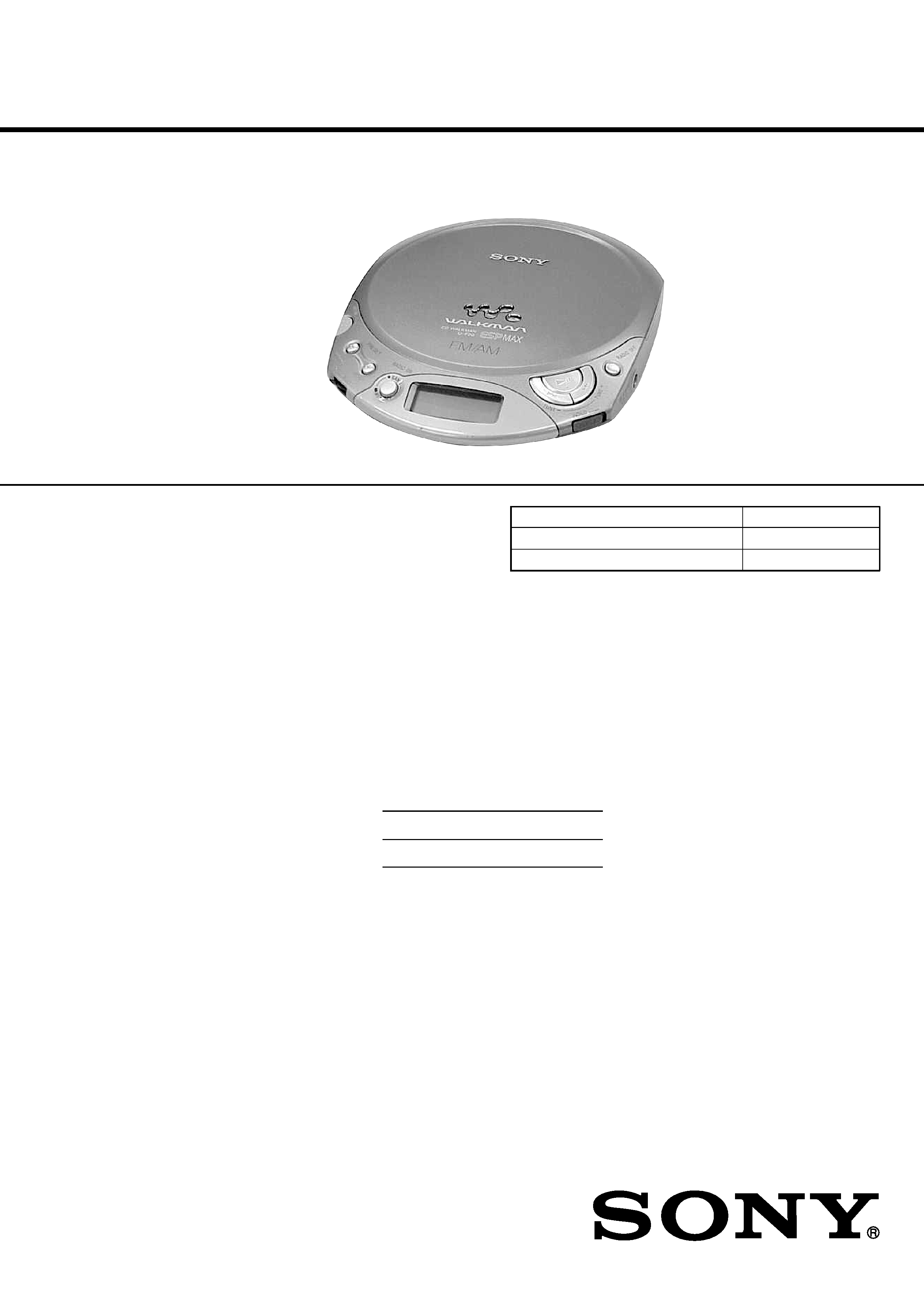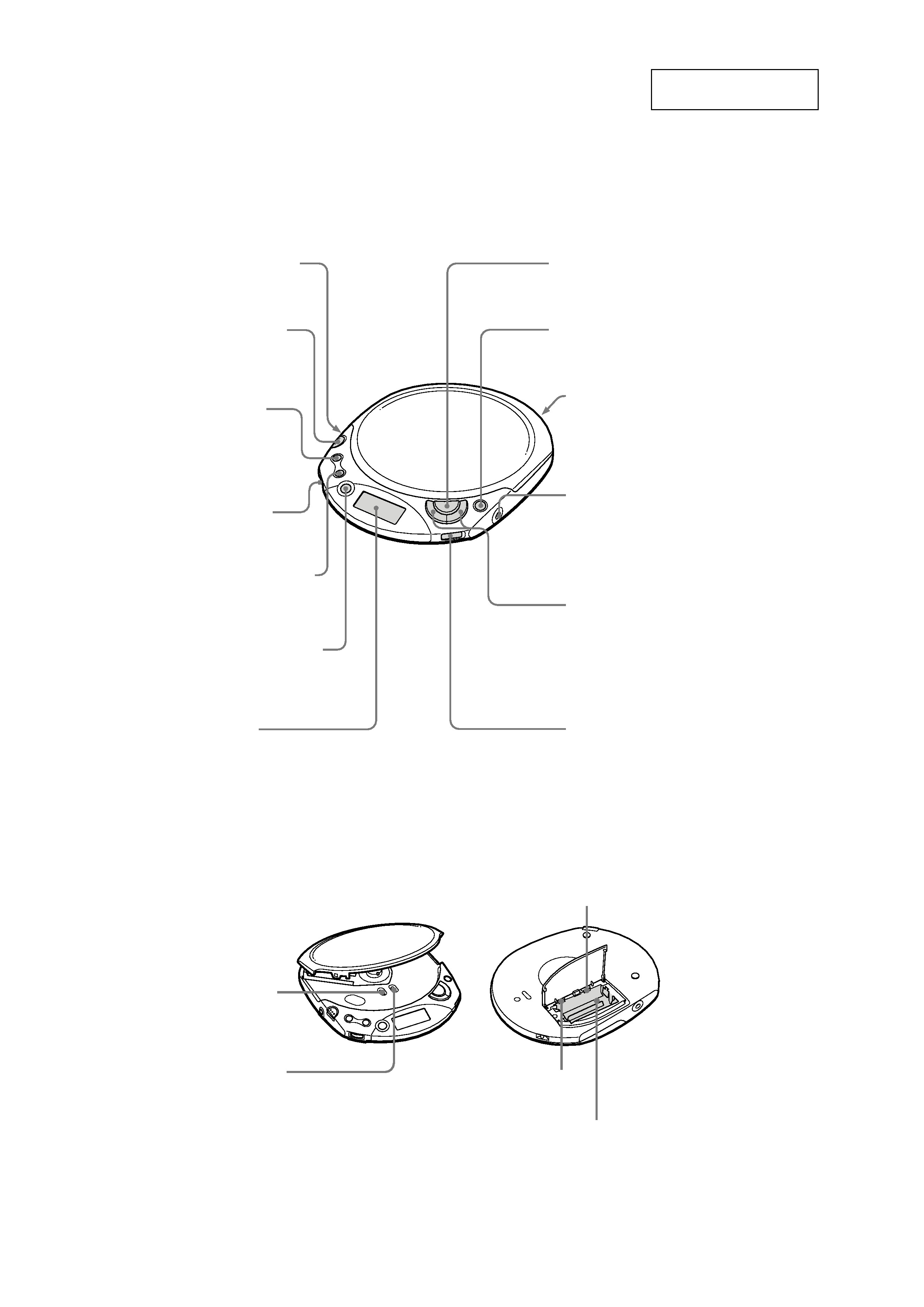
1
Model Name Using Similar Mechanism
D-E220/E225/E226CK
CD Mechanism Type
CDM-3123EBA
Optical Pick-up Name
DAX-23E
SERVICE MANUAL
US Model
D-F22ST
E Model
D-F21
D-F21/F22ST
FM/AM PORTABLE CD PLAYER
CD player
System
Compact disc digital audio system
Laser diode properties
Material: GaAlAs
Wavelength:
= 780 nm
Emission duration: Continuous
Laser output: Less than 44.6 µW (This output
is the value measured at a distance of 200 mm
from the objective lens surface on the optical
pick-up block with 7 mm aperture.)
D-A conversion
1-bit quartz time-axis control
Frequency response
20 - 20,000 Hz +1/2 dB
(measured by EIAJ CP-307)
Output (at 4.5 V input level)
Headphones (stereo minijack)
Approx. 12 mW + Approx. 12 mW
at 16 ohms
Radio
Frequency range (STEP switch)
9 kHz step:
FM: 87.5 - 108.0 MHz
AM: 531 - 1,710 kHz
10 kHz step:
FM: 87.5 - 108.0 MHz
AM: 530 - 1,710 kHz
Antenna
FM: Headphones/earphones cord antenna
AM: Built-in ferrite bar antenna
SPECIFICATIONS
General
Power requirements
For the area code of the model you purchased,
check the upper left side of the bar code on the
package.
· Two LR6 (size AA) batteries: 3 V DC
· AC power adaptor (DC IN 4.5 V jack):
US/E92/MX model: 120 V, 60 Hz
E13 model: 220 - 230 V, 50/60 Hz
Battery life* (approx. hours)
(When you use the CD player on a flat and stable
surface.)
Playing time varies depending on how the CD player
is used.
When using
ESP
RADIO
on
off
on
Two sony alkaline
24
25
66
batteries LR6(SG)
* Measured value by the standard of JEITA
(Japan Electronics and Information Technology
Industries Association).
** Charging time varies depending on how the
rechargeable battery is used.
Operating temperature
5°C - 35°C (41°F - 95°F)
Dimensions (w/h/d) (excluding projecting
parts and controls)
Approx. 161
× 26.3 × 130.3 mm
(6 3/8
× 1 1/16 × 5 1/4 in.)
Mass (excluding accessories)
Approx. 210 g (7.5 oz.)
Supplied accessories
For the area code of the location in which you
purchased the CD player, check the upper left
side of the bar code on the package.
Headphones (1)
AC power adaptor (1) (D-F21)
Design and specifications are subject to change
without notice.
· Abbreviation
E13 : AC 220 - 230V area in E model
E92 : AC 120V area in E model
MX : Mexican model
Ver 1.0 2001.10
9-873-372-01
2001J0400-1
© 2001.10
Sony Corporation
Personal Audio Company
Published by Sony Engineering Corporation

2
Flexible Circuit Board Repairing
· Keep the temperature of the soldering iron around 270°C during
repairing.
· Do not touch the soldering iron on the same conductor of the
circuit board (within 3 times).
· Be careful not to apply force on the conductor when soldering
or unsoldering.
Notes on Chip Component Replacement
· Never reuse a disconnected chip component.
· Notice that the minus side of a tantalum capacitor may be
damaged by heat.
TABLE OF CONTENTS
1. SERVICE NOTE ................................................................. 3
2. GENERAL
Getting started ......................................................................... 4
3. DISASSEMBLY
3-1. "Lid, Battery Case", Cabinet (Front) Assy .......................... 5
3-2. Lid Assy, Upper ................................................................... 5
3-3. Main Board, MD Assy ........................................................ 6
3-4. Optical Pick-up, Motor ....................................................... 6
4. ELECTRICAL ADJUSTMENTS
Tuner Section ........................................................................... 7
CD Section .............................................................................. 8
5. DIAGRAMS
5-1. IC Pin Descriptions ............................................................. 9
5-2. Block Diagram CD Section ........................................... 13
5-3. Block Diagram Tuner Section ....................................... 14
5-4. Block Diagram Power Supply Section .......................... 15
5-5. Printed Wiring Board Main Section .............................. 16
5-6. Schematic Diagram Main Section (1/3) ......................... 18
5-7. Schematic Diagram Main Section (2/3) ......................... 19
5-8. Schematic Diagram Main Section (3/3) ......................... 20
5-9. IC Block Diagrams ............................................................ 21
6. EXPLODED VIEWS
6-1. Cabinet (Front) Section ..................................................... 24
6-2. Cabinet (Lower) Section ................................................... 25
6-3. CD Mechanism Deck Section (CDM-3123EBA) ............. 26
7. ELECTRICAL PARTS LIST ......................................... 27
D-F21/F22ST
SAFETY-RELATED COMPONENT WARNING!!
COMPONENTS IDENTIFIED BY MARK 0 OR DOTTED LINE
WITH MARK 0 ON THE SCHEMATIC DIAGRAMS AND IN
THE PARTS LIST ARE CRITICAL TO SAFE OPERATION.
REPLACE THESE COMPONENTS WITH SONY PARTS WHOSE
PART NUMBERS APPEAR AS SHOWN IN THIS MANUAL OR
IN SUPPLEMENTS PUBLISHED BY SONY.

3
D-F21/F22ST
SOUND/
PRESET
S811
L3
AM
FERRITE-
ROD
ANTENNA
S801
CD DOOR
OPEN
S801
MAIN BOARD (SIDE B)
RF-IN
TAP802
MAIN BOARD (SIDE A)
SECTION 1
SERVICE NOTE
NOTES ON HANDLING THE OPTICAL PICK-UP BLOCK
OR BASE UNIT
The laser diode in the optical pick-up block may suffer electro-
static breakdown because of the potential difference generated by
the charged electrostatic load, etc. on clothing and the human body.
During repair, pay attention to electrostatic breakdown and also
use the procedure in the printed matter which is included in the
repair parts.
The flexible board is easily damaged and should be handled with
care.
Precautions for Checking Emission of Laser Diode
Laser light of the equipment is focused by the object lens in the
optical pick-up so that the light focuses on the reflection surface
of the disc. Therefore, be sure to keep your eyes more then 30 cm
apart from the object lens when you check the emission of laser
diode.
Before Replacing the Optical Pick-Up Block
Please be sure to check throughly the parameters as par the "Opti-
cal Pick-Up Block Checking Procedures" (Part No.: 9-960-027-
11) issued separately before replacing the optical pick-up block.
Note and specifications required to check are given below.
· FOK output : IC601 eg pin
When checking FOK, remove the lead wire to disc motor.
· RF signal P-to-P value : 0.45 ± 0.1 Vp-p
· The repairing grating holder is impossible.
Laser Diode Checking Methods
During normal operation of the equipment, emission of the laser
diode is prohibited unless the upper lid is closed while turning ON
the S801. (push switch type)
The following two checking methods for the laser diode are
operable.
· Method:
Emission of the laser diode is visually checked.
1. Open the upper lid.
2. With a disc not set, turn on the S801 with a screwdriver having a
thin tip as shown in Fig.1.
or TAP802 is shorted as shown in Fig.2.
Note: Do not push the detection lever strongly, or it may be bent
or damaged.
3. Press the N X button.
4. Observing the objective lens, check that the laser diode emits
light.
When the laser diode does not emit light, automatic power
control circuit or optical pick-up is faulty.
In this operation, the objective lens will move up and down 5
times along with inward motion for the focus search.
Fig. 2
Fig. 1
detection lever
detection lever
main board
S801

4
D-F21/F22ST
Locating the controls
For details, see pages in parentheses.
CD player (front)
1 i (headphones)
jack
(page 6)
7 Display
(pages 8 - 14)
4 VOLUME
control
(page 6)
5 MENU/PRESET +
button
(pages 8, 11, 12)
2 OPEN button
(page 6)
3 SOUND/
PRESET
button
(pages 11 - 13)
qa DC IN 4.5 V
(external power
input) jack
(page 18)
8
u (play/pause)
button
(pages 6, 7)
9
x (stop) ·RADIO OFF
button
(pages 7, 9, 11, 15)
q; Strap holes
6 RADIO ON·BAND/
MEMORY button
(pages 9 - 12)
qd HOLD switch
(page 14)
qs
./ >
(AMS/search) ·
TUNE /+ buttons
(pages 7 - 9, 11)
CD player (inside)
qg AVLS switch
(page 14)
CD player (rear)
qf ESP switch
(page 13)
qh E13 model:
MONO/ST (stereo) switch (page 10)
Other models:
LOCAL/DX switch (page 10)
qk Battery compartment
(page 17)
qj STEP switch
(page 12)
SECTION 2
GENERAL
This section is extracted
from instruction manual.

5
D-F21/F22ST
Note : Follow the disassembly procedure in the numerical order given.
3-2. LID ASSY, UPPER
SECTION 3
DISASSEMBLY
3-1. "LID, BATTERY CASE", CABINET (FRONT) ASSY
1
B 2x10
3
B 2x10
4
claws
0
cabinet (upper) assy
5
claws
6
claws
7
claws
8
9
2
lid, battery case
boss
1
claws
2
lid assy, upper
cabinet (front) assy
